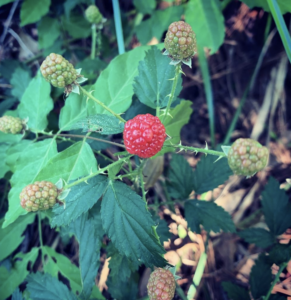On April 5, we noticed the first ripe dewberry growing in the woods behind TFBT farms. We are located in hardiness zone 9a, so it’s already pretty warm this time of year in the humid tropics. Over the past week, we have picked a few pounds of berries and there are plenty more ripening and some still just coming in. It’s important to leave some berries on the vine to ensure that the natural environment and ecosystem isn’t disrupted.
Even here in the northern suburbs of Houston, Texas, we share this wooded area with a colony of native cottontail swamp rabbits (Sylvilagus aquaticus), eastern fox squirrels (Sciurus niger), and a variety of woodpeckers, owls, and the occasional pack of coyotes even. It’s important to only harvest about 10% of the berries being produced to allow the birds, rabbits, and squirrels to continue their foraging efforts with minimal disruption.
Only harvesting about 10% of the yield, in addition to allowing wildlife to feed, also helps ensure a harvest next year. When fruits get ripe and fall off the plant and ripen, or if they get eaten, they are eventually returned to the soil where they can grow into a new plant. If you don’t leave some fruit on the plant during this harvest, you won’t have a healthy rotation of new plants coming in throughout the years.
We picked for a few days before making the first batch of jam.
Recipe
• 5 pounds dewberries, ripen and near-ripe berries
• 3.5 cups sugar
• 1 medium lemon, zested and juiced
We use this same recipe for many berry jams including dewberries, blackberries, strawberries, blueberries, etc. If you don’t have access to under-ripened berries, you can easily add in store bought pectin instead and achieve the same resulting jam.
Yield
about 45 fluid ounces of jam









